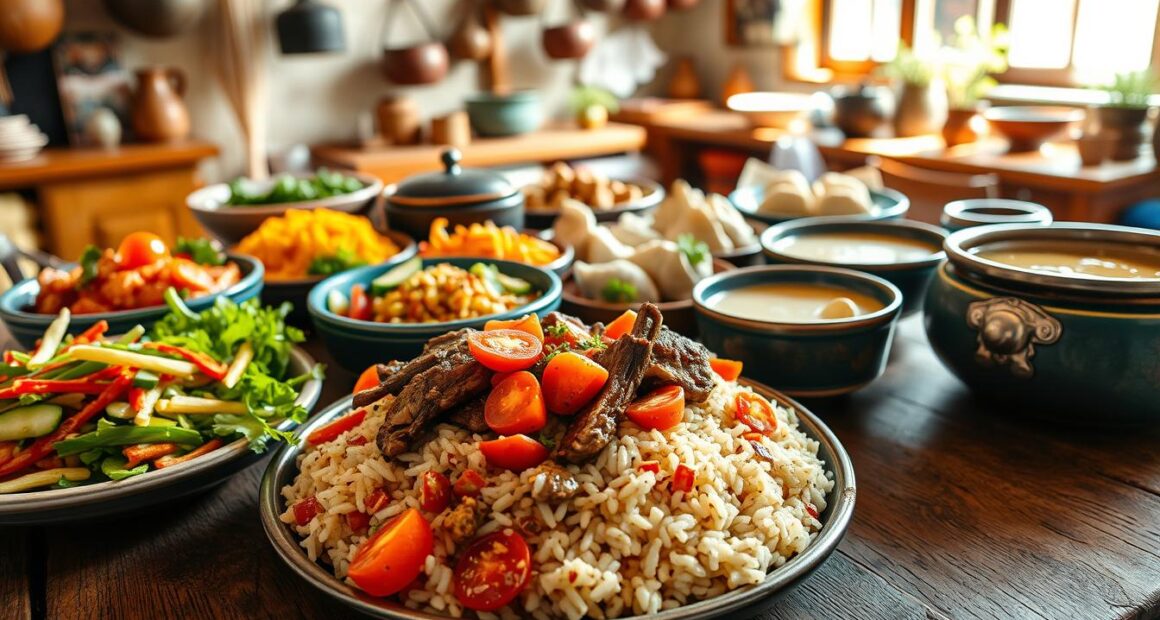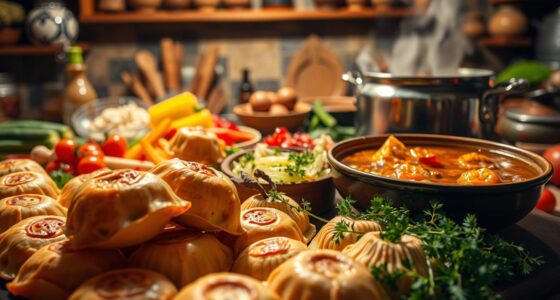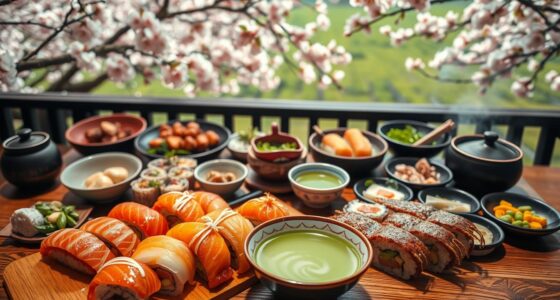Imagine diving into a flavorful escape that takes you on a journey through history, culture, and warmth. When you think of Uzbek cuisine, what comes to mind? Perhaps a vibrant festival where generous helpings of plov are served, each grain of rice a story of the land it comes from. These are not just traditional dishes; they are a tapestry of experiences waiting to unfold on your palate. Uzbekistan, a double-landlocked nation, offers a unique culinary perspective shaped by its geography and influences along the Silk Road. Each dish embodies the essence of a rich culture steeped in hospitality and flavor, from the comforting manti to the savory delight of lagman. Join us as we explore must-try dishes that showcase not only the ingredients but also the heartfelt traditions behind them.
Key Takeaways
- Uzbekistani cuisine is influenced by its unique geographical characteristics.
- Plov symbolizes generosity and is commonly served at weddings and festivals.
- Manti dumplings are traditionally filled with a blend of meat and spices.
- Lagman features hand-pulled noodles that highlight traditional culinary techniques.
- Samsa pastries reflect Central Asian cooking practices, specifically being baked in a tandoor.
- Achichuk salad showcases fresh ingredients prominently used in Uzbek cuisine.
Introduction to Uzbek Cuisine
Uzbek cuisine offers a vibrant mosaic of flavors, deeply rooted in its rich culinary heritage. With influences from Central Asia, Middle Eastern, and Russian cuisines, every dish tells a story. You will find that aromatic spices play a prominent role, enhancing hearty meat dishes and flavorful rice preparations. Fresh ingredients sourced from local farms contribute to the authenticity of each dish, ensuring a genuine dining experience.
In Uzbekistan, food transcends mere sustenance; it symbolizes community and hospitality. Traditional meals, often served during large family gatherings and significant celebrations, cement bonds among family members and friends. For instance, palov, the national dish, is often made in vast quantities to feed hundreds, highlighting the importance of sharing a meal.
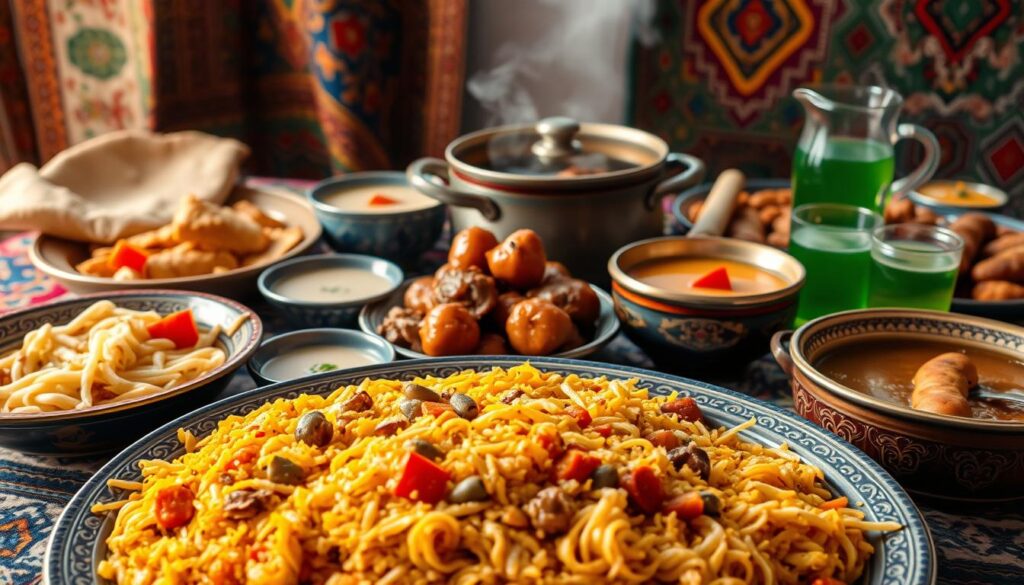
The emphasis on communal dining reinforces the integral role of uzbek cuisine in cultural life. Ideas about food are not just about nourishment; they reflect customs and traditions that have been passed down through generations. As you explore this culinary landscape, you will discover the essence of Uzbek culture embodied in every dish.
The Heart of Uzbek Dining: Plov
In Uzbekistan, plov is more than just a meal; it is a beloved and cherished traditional dish that brings families together. Often enjoyed during communal gatherings that can involve up to five generations, plov encapsulates the cultural significance of hospitality. Prepared with care, this rice pilaf is typically made with lamb or beef, slow-cooked in a kazan, a heavy cast iron pot that imparts a unique flavor through hours of simmering.
What is Plov?
Plov, often referred to as osh, consists of tender meat, perfectly seasoned rice, and an array of spices that create a tantalizing aroma. The dish’s preparation is a ritual and is primarily carried out by the men in the family, marking a cultural distinction in cooking practices. With its deep roots in Uzbek cuisine, plov is a must-try for anyone looking to immerse themselves in the local food culture.
Variations of Plov
There are countless plov variations throughout Uzbekistan, showcasing remarkable regional differences in ingredients and preparation methods. For instance, the famous cities of Bukhara and Samarkand present their unique twists. Some variations may include chickpeas, raisins, or seasonal vegetables, allowing each region to express its culinary heritage. This array of recipes reaffirms the versatility of this traditional dish.
Why You Can’t Miss It
Don’t miss the opportunity to enjoy plov during your culinary adventures in Uzbekistan. The dish is not just a delightful experience for your taste buds, but it also embodies the essence of community and connection, often served during family reunions or significant celebrations. Sharing a plate of plov is a testament to generosity and Uzbek hospitality. With its rich flavors and cultural significance, plov undeniably stands as the heart of Uzbek dining, making it a crucial element of any culinary exploration in the region.
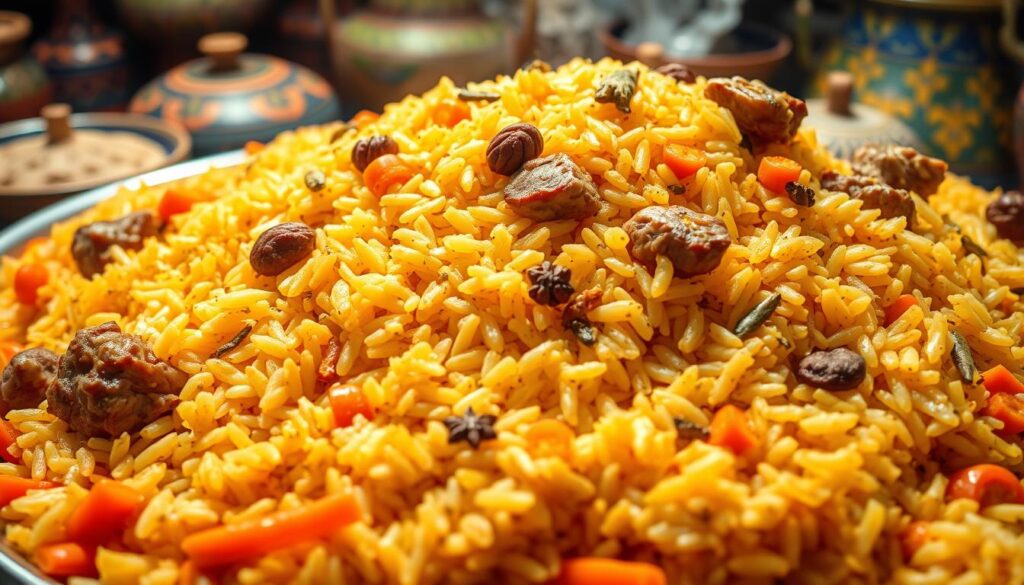
Satisfy Your Cravings with Manti
Manti are a delightful choice when exploring the rich flavors of Uzbek cuisine. These traditional dumplings come filled with a savory mixture that speaks to the heart of this cultural culinary experience. With their unique preparation method and flavors, manti are perfect for satisfying your cravings during family gatherings or special occasions.
What are Manti?
Manti are traditional dumplings, usually crafted from a simple dough made of flour and water. The filling often consists of either ground lamb or beef, mixed with diced onions and a blend of spices like cumin and coriander. This combination creates a flavorful explosion in every bite. The meticulous process of making manti involves handcrafting each dumpling, which showcases the labor-intensive nature of this dish.
Traditional Serving Styles
When it comes to serving manti, tradition plays a crucial role. They are typically accompanied by a garlic yogurt sauce for dipping, as well as a rich tomato-based sauce that enhances their flavor. Both sauces can be prepared while the dumplings steam, allowing for an efficient cooking experience. In many households, the preparation of manti becomes a family affair, often prepared at least once or twice a month during festivities.
Steaming manti usually takes about 10 to 15 minutes until the wrappers become slightly translucent and firm, indicating they are ready to devour. Serving manti in large quantities, around 50 dumplings at a time, makes them perfect for sharing and enjoying the company of loved ones.
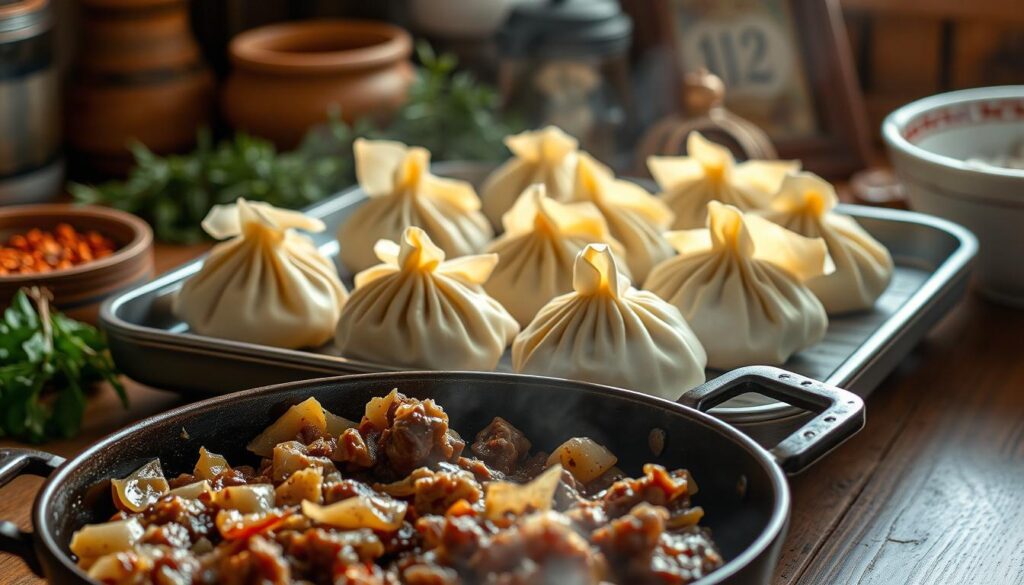
A Taste of Tradition: Lagman
Lagman is more than just a noodle dish; it embodies the rich tapestry of Uzbek food and its historical significance. Originating from Uyghur cuisine, this comforting dish has traces of various cultures, thanks to the Silk Road. Over the years, lagman has grown into a vital element of Uzbek meals, cherished for its robust flavor and heartiness. The hand-pulled noodles, flavorful broth, and a medley of meats and vegetables create a delightful experience during meals.
The History of Lagman
The historical significance of lagman can be traced back to its roots in Central Asia. Influences from Uyghur, Persian, and even Russian cuisines have melded over time, establishing lagman as a staple in many Uzbek households. The art of making the hand-pulled noodles is a tradition often passed down through generations, showcasing the skills required to create this delightful noodle dish. Each bowl typically reflects the vibrant culinary history of the region.
How to Enjoy Lagman
Knowing how to enjoy lagman enhances the experience of this delicious dish. Traditionally, it is served hot and is often accompanied by fresh Uzbek bread. The combination of chewy noodles, tender cuts of meat, and a zesty broth makes for a satisfying meal. Whether hosting family gatherings or casual dinners with friends, sharing lagman brings a sense of community. Pair it with a side of fresh vegetables or pickles to elevate the meal further.

Naan: The Soul of Uzbek Bread
Naan holds a special place in Uzbek cuisine, serving as a vital staple that complements a variety of dishes. When exploring the rich tapestry of uzbek bread, you’ll discover several types of naan, each with its unique characteristics and flavors. The traditional tandoor oven plays a crucial role in creating the perfect texture, contributing to its iconic crusty exterior and soft interior.
Types of Naan
Among the numerous types of bread available in Uzbekistan, the most notable is the obi non, often recognized by its round shape and shallow depression in the center. Tashkent-style non is particularly loved for its lighter, softer, and chewier texture. Bukhara non offers a denser alternative with a touch of blackened nigella seeds, showcasing the regional specialties of this diverse country. Each loaf is typically adorned with decorative patterns, crafted by hand using traditional tools like chekich and bosma, making every batch truly unique.
Pairing Naan with Dishes
Pairing naan with various dishes enhances your dining experience, making it an essential element of meals throughout Uzbekistan. You’ll frequently find it accompanying steaming bowls of soups or rich stews, as well as delicious rice dishes like plov. Engaging in the tradition of breaking bread by hand, rather than cutting it with a knife, fosters a sense of communion that is deeply ingrained in Uzbek culture. Sharing naan not only brings people together but also elevates the enjoyment of traditional accompaniments served across the table.

Savory Treats: Samsa
Samsa stand out as one of the most beloved street food options in Uzbekistan, showcasing a rich history that dates back to the 11th century. These savory pastries are crafted with care, filled with spiced ground meat and various vegetables or potatoes, making them incredibly delicious. Baked in a traditional Tandoor oven, samsa develop a unique golden, crispy exterior that perfectly contrasts with the tender, flavorful filling.
What are Samsa?
Samsa are not just ordinary pastries; they possess a fascinating lineage rooted in Persian cuisine, inspired by the dish known as sanbosag, which translates to “triangular pastry.” Each one is handmade by skilled artisans who fold the dough around the savory filling, a testament to culinary craftsmanship. Their journey from the Silk Road to the streets of New York showcases the cultural exchange between regions and the popularity of this dish.
Perfect Dipping Sauces
When it comes to how to serve samsa, accompanying them with the right dipping sauces elevates the tasting experience. Common choices include a rich tomato sauce that complements the meaty flavors perfectly or a refreshing yogurt dip that balances the spices. Many locals cherish the practice of pairing samsa with a hot cup of tea, creating a delightful snack that warms the soul. The combination of these elements enhances the overall enjoyment of this iconic street food.

Delightful Desserts: Halva
Halva stands out as a beloved traditional dessert across Central Asia, especially in Uzbekistan. Made primarily from tahini, sugar, and a hint of cardamom or vanilla, this treat boasts a charming blend of flavors and textures. You will find various types of halva, each offering a unique twist on this classic. The preparation is straightforward, taking only about 20 minutes, but it requires a 24-hour setting time to achieve the perfect consistency.
The Different Types of Halva
Uzbek halva comes in several delightful variations. Here’s a brief overview of some popular types:
| Type of Halva | Main Ingredients | Texture |
|---|---|---|
| Classic Halva | Tahini, sugar, cardamom, vanilla | Creamy, crumbly |
| Halvaitar | Semolina, sugar, butter | Coarser, denser |
| Nut-Infused Halva | Tahini, nuts, sugar | Creamy with nutty bits |
| Fruit-Flavored Halva | Dried fruits, tahini, sugar | Chewy, fruity |
Serving Suggestions
When it comes to serving halva, you have many delightful options. Traditionally, this sweet treat pairs well with tea or coffee, creating a delightful contrast to the beverage. Consider the following ways to present your halva:
- Enjoy halva plain, allowing its rich flavors to shine.
- Garnish with chopped nuts for an added crunch.
- Serve with green tea, enhancing your traditional dessert pairing experience.
- Include halva on a dessert platter during holidays or family gatherings.
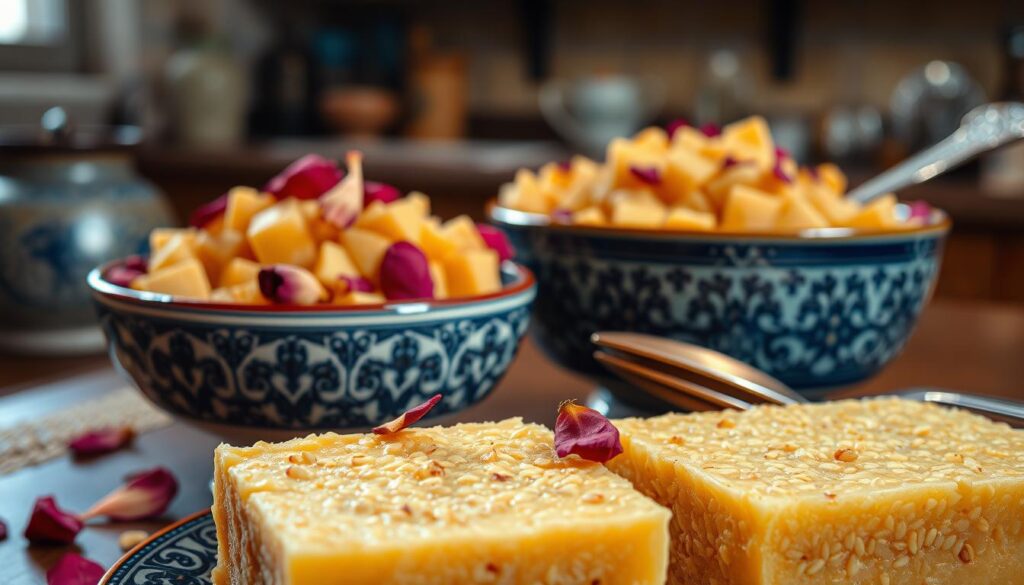
Sip on Tea: Chai Culture
In Uzbekistan, tea drinking holds a significant place in everyday life and social interactions. The rich chai culture reflects a deep appreciation for hospitality, warmth, and community. With the country boasting one of the highest tea consumption rates per capita, it’s evident that tea is more than just a beverage; it’s a comforting ritual that brings people together.
Types of Uzbek Tea
Uzbekistan offers a delightful variety of tea, each with its unique flavor profile. The most popular among the types of uzbek tea is green tea, known locally as “kuk-choy.” This type is traditionally served without any sugar or milk to highlight its natural flavors. In contrast, black tea, or “kora-choy,” is particularly favored in cities like Tashkent. The country’s diverse preferences also include milk tea, or “ok-chai,” making the selection broad and appealing.
The Ritual of Tea Drinking
The tea drinking ritual in Uzbekistan unfolds as a cherished tradition. It starts as guests arrive, with tea served almost immediately – a gesture representing genuine hospitality. Preparing the tea involves an intricate process, where the tea is poured from the teapot into small ceramic cups called pialas and then returned to the pot three times. This practice, emphasizing thorough tea infusion, showcases the ritualistic aspect of this beloved drink.
Chai houses, or chaikhanas, play a pivotal role in Uzbek culture as social hubs where friends and family gather to enjoy tea. It’s not uncommon for conversations to flourish in these charming establishments, often adorned with beautiful decor and soft seating. Guests sip their tea while savoring sweet delicacies like navat, crystallized sugar, which complements each cup’s warmth perfectly.
Overall, tea drinking in Uzbekistan is a celebration of life, community, and tradition, reflecting a strong understanding of the values held dear in uzbek culture.

A Flavorful Feast: Shashlik
Shashlik stands as a beloved culinary staple in Central Asian cuisine, renowned for its grilled meat skewers. This dish, often enjoyed at social gatherings, exemplifies the art of cooking over an open flame, transforming marinated chunks of meat into tender, juicy delights. The process of preparing shashlik highlights the rich culinary heritage of Uzbekistan and its surrounding regions.
What is Shashlik?
At its core, shashlik refers to skewered and marinated meat, traditionally made from lamb, beef, or chicken. The quality of meat is often exceptional, owing to free-range practices in the region, ensuring that each bite bursts with flavor. To prepare this dish, 1 kg of beef sirloin is cut into large chunks with generous pieces of fat, enhancing moisture during the grilling process. The marinade, which includes 600 ml of sparkling water, is designed to tenderize the meat, while spices such as cumin and coriander enhance the overall flavor profile. A resting period of at least 5 hours or overnight in the marinade is recommended to achieve the best texture and taste.
Ideal Accompaniments
When it comes to pairing shashlik, traditional sides play a crucial role in balancing the meal. Common options include:
- Lavash: A soft flatbread perfect for wrapping around pieces of shashlik.
- Pickled Onions: A tangy contrast that complements the rich flavors of the grilled meat.
- Fresh Salad: Typically made from tomatoes, cucumbers, and onions, these salads add a refreshing touch.
- Sour Cream: A dollop of sour cream can create a creamy contrast to the smokiness of the shashlik.
This combination not only enhances the taste but also provides a pleasing variety of textures and flavors, making each bite a celebration of Uzbek dining culture.
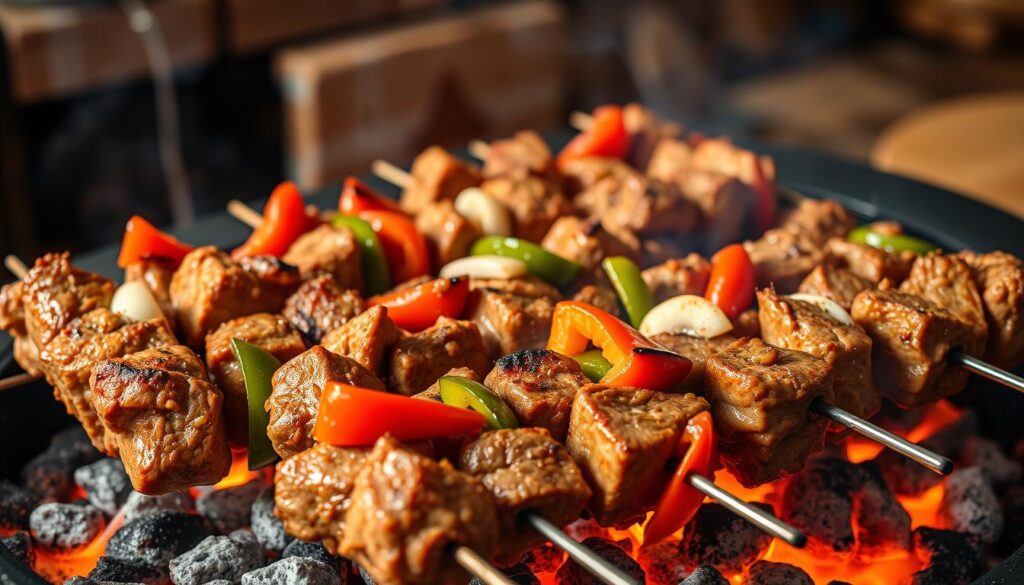
Bold Flavors: Achichuk Salad
Achichuk salad stands out as a vibrant and essential dish in Uzbek cuisine, known for its delightful balance of flavors and textures. Made primarily from fresh ingredients, it offers a refreshing taste that enhances any meal. This fresh salad typically incorporates thinly sliced tomatoes, cucumbers, and onions, all combined with a zesty dressing of vinegar and vegetable oil, reflecting the lush produce of Uzbekistan’s fertile lands.
Ingredients of Achichuk
The quintessential achichuk salad consists of:
- Tomatoes
- Cucumbers
- Red onions
- Fresh herbs like cilantro and dill
- Salt and pepper
- A splash of vinegar or lemon juice
This combination of fresh ingredients makes achichuk a staple, especially during summer months when tomatoes are at their juiciest. Its crunchy texture and vibrant colors make it visually appealing as well.
Health Benefits of Achichuk
Achichuk salad offers several health benefits. The fresh vegetables provide essential vitamins and minerals, making it a nutritious addition to any diet. This dish promotes hydration and supports digestive health thanks to its high water content and fiber. Including this fresh salad in your meals can balance out richer dishes, allowing for a lighter, healthier dining experience.
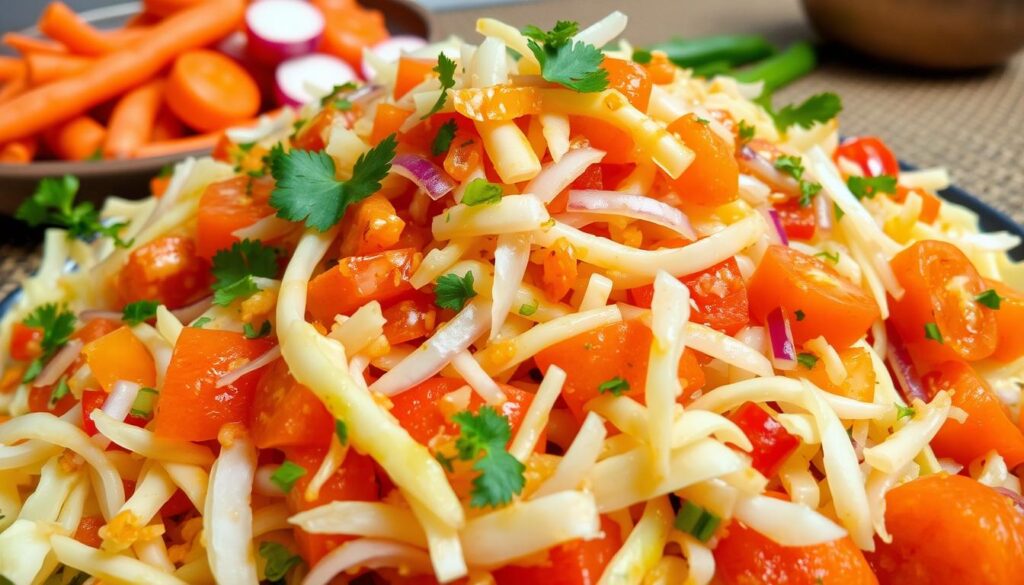
Unique Treats: Borak
Diving into the world of Uzbek cuisine, you will discover borak, a delightful treat that stands out among savory dumplings. These stuffed pastries are a beloved part of the culinary landscape, offering a variety of fillings and cooking methods that reflect the rich tradition of this cuisine.
Different Fillings for Borak
One of the most exciting aspects of borak is the wide range of fillings. You can savor:
- Ground meat, often prepared with onions and spices
- Potatoes mixed with herbs and seasonings
- Sweet pumpkin, which adds a unique twist
- Cheese and herb combinations for a savory bite
Each filling brings its own flavor, making borak a versatile choice for any occasion. Whether you’re in the mood for something hearty or something a bit sweeter, there is a borak variation to satisfy your cravings.
Cooking Techniques
The cooking techniques used for borak preparation greatly influence the overall experience. Common methods include:
- Frying: Produces a crispy, golden exterior that pairs beautifully with the soft filling.
- Baking: Offers a healthier option while ensuring a delightful crunch.
- Steaming: Results in a tender texture, preserving the juiciness of the fillings.
Each method brings out different attributes, showcasing the adaptability of borak. Whether you enjoy them crispy or soft, these savory dumplings provide a unique taste experience that captures the essence of Uzbek cooking.
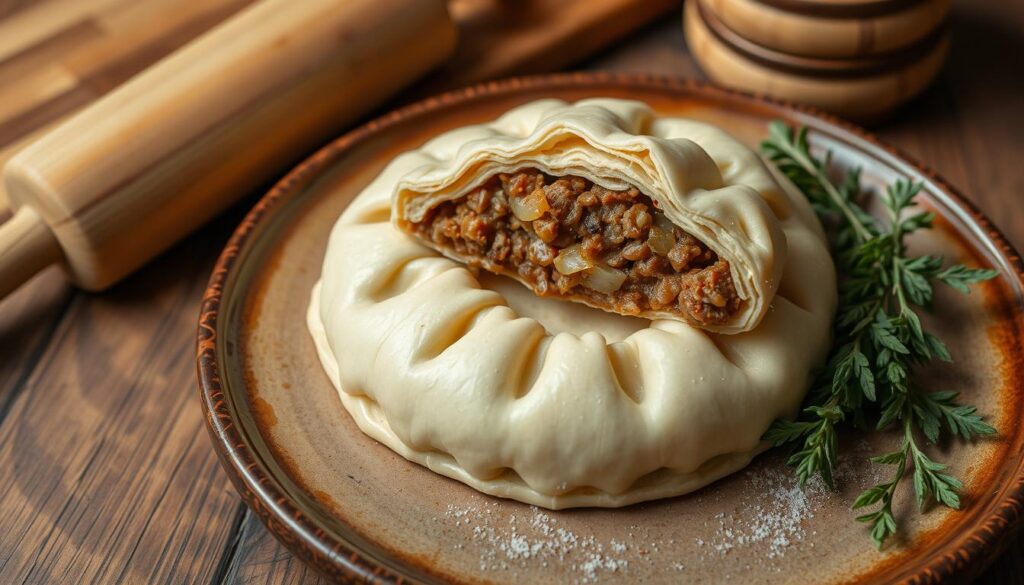
Spiced Delights: Plov Culture
Plov, often recognized as the national dish of Uzbekistan, holds a rich and significant place in the plov culture. This dish is not only a staple in households but also an essential part of social gatherings and celebrations. Understanding the spices used and the techniques behind making an authentic plov can elevate your cooking experience at home.
The Role of Spices in Plov
Spices play a crucial role in creating the unique flavors found in plov. Commonly used spices include cumin, coriander, and turmeric, which lend an earthy richness to the dish. Each plov recipe may vary by region, and the spices selected reflect local traditions. This variation adds depth to the dish’s cultural significance, highlighting that a shared love for plov can look different in homes across Uzbekistan.
How to Make Your Own Plov
Cooking plov at home can be a rewarding experience. To replicate this beloved dish, begin with quality ingredients: typically, you will need 2 cups of long-grain rice, 1 pound of lamb or beef, 4 large carrots, and 2 large onions. The cooking process involves simmering these ingredients for about 1 hour, reinforcing the idea that great meals require patience.
For the best results, use a kazan if available; otherwise, a heavy pot will suffice. Start by sautéing your meat, then incorporate the vegetables and rice according to your chosen plov recipe. Each step is essential to achieving the authentic taste reminiscent of gatherings and celebrations in Uzbekistan.
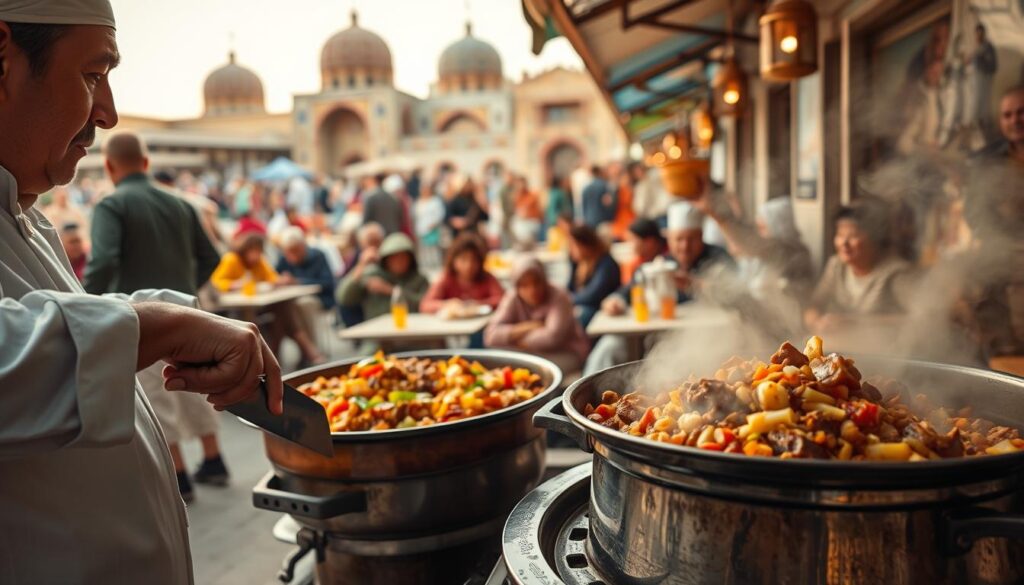
Traditional Beverages: Ayran
Ayran stands out as a refreshing yogurt-based drink deeply rooted in Uzbekistan’s culinary traditions. Made from katyk, which is fermented cow’s or sheep’s milk, ayran is blended with either sparkling or still water, a pinch of salt, and sometimes herbs, creating a deliciously creamy, tangy beverage. This drink is not only enjoyed for its unique flavor but also brings many health benefits, especially in warm weather.
What is Ayran?
Ayran is a beloved traditional drink, widely consumed across Central Asia, including in Uzbekistan. The thick goodness comes primarily from katyk, allowing it to maintain its freshness even without refrigeration due to its natural preservative properties. In traditional guesthouses, ayran is commonly served at breakfast, reflecting its integral role in daily meals.
Why Ayran is a Must-Try
When exploring Uzbek cuisine, ayran emerges as a must-try traditional beverage. This drink superbly complements rich dishes like plov and shashlik, enhancing your overall dining experience. Enjoying ayran not only cools the palate but also assists in digestion, making it especially popular during the hot summer months. The presence of ayran in markets of Tashkent and Samarkand showcases its significance, with various vendors offering it alongside other dairy delights.

The Influence of Silk Road on Cuisine
The rich tapestry of Uzbek cuisine owes much to the historical significance of the Silk Road, a vital network that facilitated not just trade but cultural exchange. This ancient route allowed spices, ingredients, and cooking methods to flow into Uzbekistan, enhancing the culinary landscape with diverse flavors. Today, the legacy of this silk road influence is evident in the vibrant array of traditional meals.
How Trade Shaped Uzbek Dishes
Approximately 50% of traditional Uzbek dishes incorporate ingredients that were historically traded along the Silk Road. Meals such as Plov highlight this fusion, showcasing variations influenced by Persian, Arabic, and Mongolian cuisines. The reliance on meat, particularly lamb and beef, remains significant, with over 70% of Uzbek meals centered around these staples, which were regularly exchanged along trade routes.
Modern Influences on Traditional Meals
Uzbek cuisine continues to evolve, embracing modern influences while retaining the essence of traditional meals. The introduction of noodles to the culinary repertoire reflects Chinese influence, with noodle dishes now popular in over 40% of meals. Furthermore, tea drinking, rooted in Silk Road traditions, sees approximately 80% of the population indulging in daily rituals. This blend of historical and modern influences creates a culinary experience that reveres its origins yet adapts to contemporary tastes.
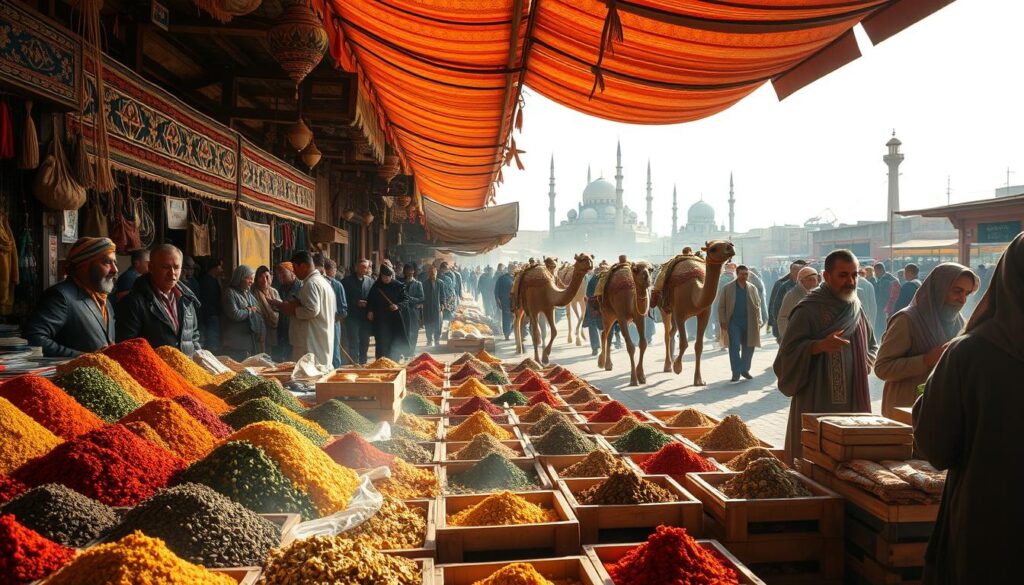
Conclusion: Exploring Uzbek Cuisine
Diving into the rich tapestry of Uzbek cuisine is truly an exciting culinary adventure. With its unique blend of flavors influenced by Islamic, Mongolian, and Russian cultures, exploring Uzbek cuisine allows you to savor a variety of traditional dishes. From the nationally celebrated plov to the ubiquitous naan, every meal is steeped in culture and tradition. These dishes not only satisfy your palate but also offer a glimpse into the vibrant heritage of Uzbekistan, making it a must-try for anyone keen on culinary exploration.
As you embark on your journey to taste these delightful offerings, finding Uzbek restaurants near you can enhance your experience. Major cities have witnessed a rise in Uzbek eateries, reflecting a growing interest in local cuisine. Checking local restaurant directories or food blogs can lead you to hidden gems that serve authentic dishes. Additionally, community recommendations and online reviews can guide you in discovering venues where you can immerse yourself in the true flavors of Uzbekistan.
Ultimately, discovering the wonders of Uzbek dishes is about more than just food; it connects you to the country’s rich storytelling through its culinary practices. By exploring these diverse offerings, you become part of a broader narrative that celebrates family, hospitality, and tradition, making your dining experience all the more meaningful.
